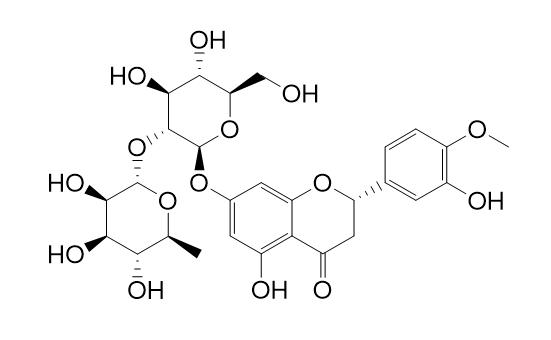Natural Products
Neohesperidin
| Catalog No. | CFN99125 |  |
| CAS No. | 13241-33-3 | |
| Molecular Weight: | 610.56 | |
| Molecular Formula | C28H34O15 | |
| DBs | [PubChem]:274951293 [ChEMBL]:59016 [PCIDB]:987 |
Standard InChI:
InChI=1S/C28H34O15/c1-10-21(33)23(35)25(37)27(39-10)43-26-24(36)22(34)19(9-29)42-28(26)40-12-6-14(31)20-15(32)8-17(41-18(20)7-12)11-3-4-16(38-2)13(30)5-11/h3-7,10,17,19,21-31,33-37H,8-9H2,1-2H3/t10?,17-,19?,21-,22+,23-,24-,25?,26?,27-,28+/m0/s1
Biological Activity
Neohesperidin is a natural new nutrition sweetener, widely existing in plants of dry citrus peel, which can be derived from extraction; since the sweetness is 1,300-1,500 times greater than that of sugar, neohesperidin are widely used in fruit juices, wines, beverages, bakeries and pharmaceutical formulations, and are particularly suitable for consumption by diabetic patients.[1]
Neohesperidin exhibits antioxidant activity (IC50=22.31ug/mL) in the 1,1-diphenyl
-2-picryldydrazyl (DPPH) radical-scavenging assay; neohesperidin (50mg/kg) significantly inhibits 55.0% of HCl/ethanol-induced gastric lesions, and increases the mucus content; In pylorus ligated rats, neohesperidin (50 mg/kg) significantly decreases the volume of gastric secretion and gastric acid output, and increases the pH; suggests that neohesperidin isolated from PF may be useful for the treatment and/or protection of gastritis. [2]
Neohesperidin has free radical scavenging activity, can induce cellular apoptosis in human breast adenocarcinoma MDA-MB-231 cells via activating the Bcl-2/Bax-mediated signaling pathway.[3]
Neohesperidin can attenuate cerebral ischemia-reperfusion injury via the inhibition of neuronal and oxidative stress through the regulation of the apoptotic pathway and activating the Akt/Nrf2/HO-1 pathway.[4]
Neohesperidin and hesperidin are the major flavanones isolated from bittersweet orange, they have potent anti-inflammatory effects in various inflammatory models, they significantly aggravate gastric damage caused by indomethacin administration as evidenced by increased ulcer index and histopathological changes of stomach.[5]
Neohesperidin, Albiflorin, and Aloeemodin have a potent inhibitory effect on Aβ1-40 and Aβ1-42 aggregation, and have neuroprotective effect on primary hippocampal cells against β-Amyloid induced toxicity.[6]
Product
References
[1] Yang H J, Jeong S Y, Choi N S, et al. 생명과학회지, 2010,11, 1691-6.
[2] Lee J H, Lee S H, Kim Y S, et al. Phytother Res, 2009, 23(12):1748–53.
[3] Xu F, Zang J, Chen D, et al. Nat Prod Commun, 2012, 7(11):1475-8.
[4] Wang J J, Cui P. J Asian Nat Prod Res, 2013, 15(9):1023-37.
[5] Hamdan D I, Mahmoud M F, Wink M, et al. Environ Toxicol Phar, 2014, 37(3):907-15.
[6] Ho S L, Poon C Y, Lin C, et al. Curr Alzheimer Res, 2015, 12(5):424-33.
[7] Wang Q H, Gao S H, Xiong X J, et al. Academic Journal of Second Military Medical University, 2015, 36(8):917-21.
Product Use Citation





